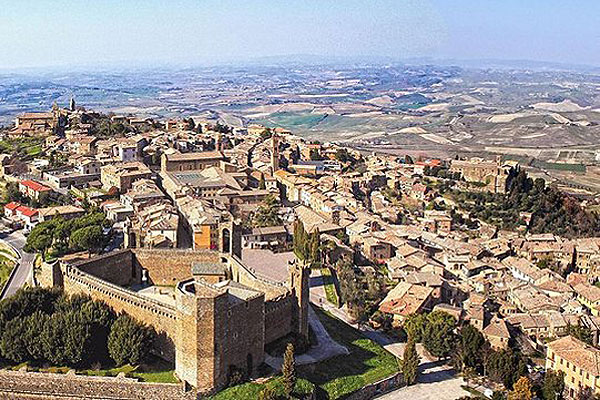Montepulciano is located on a hill, 605 meters above the sea level, and the landscape is made even more pleasant by the cultivation of olive trees and vineyards.
Montepulciano is a very characteristic little city in Tuscany, the famous Italian region. The particular location on the hilly ridge between Valdichiana and Val d ’Orcia has marked its history, also characterizing its urban design. The Municipality of Montepulciano has about 15,000 inhabitants and covers an area of 165 square kilometres. It is located on a hill, 605 meters above the sea level, and the landscape is made even more pleasant by the cultivation of olive trees and vineyards.
It was certainly inhabited in Etruscan times. Later on, Florentines and Sienese clashed several times for the possession of Montepulciano, and in 1232 the Sienese managed to seize the city after having razed its walls. From this moment, and for about three centuries, the city alternately entered the Sienese or Florentine government. Its large-scale merchant activities benefitted from the city's privileged position on important roads, while local businesses relied on a market that acts as an exchange node between the agricultural products of Valdorcia and of Valdichiana.
If three hundred is a century of great urban prosperity, it is also the moment in which we witness the maturation of lively conflicts within the dominant groups, up to the establishment of the lordship of the Del Pecora family, who governed it up to the submission of Montepulciano to the Florentines in 1390.
During the fifteenth century, the effects of the Florentine domination can be found in the city not only as regards the political-administrative aspect, but also in the more properly architectural-urbanistic field. In fact, on the already established settlement plant, there is a work of redevelopment of the main streets.
The importance of the city is underlined by its erection as a bishopric in 1561 and starting from this period numerous and grandiose religious constructions were carried out. From the middle of the eighteenth century, coinciding with the Lorraine program aiming at an arrangement of the Valdichiana, we are witnessing a slow process of redevelopment within the city fabric. But the definitive impact on the functions of the city took place at the end of the Valdichiana reclamation, when the new viability of the plains connecting Arezzo, Foiano, Bettolle, Chiusi was traced. The reflexes of this new organization of the territory are clearly legible in all the hill towns adjacent to the Valdichiana through a discrete increase in population. But the construction of the railway line at the bottom of the valley, in 1844, favors a first shift downstream of commercial and productive activities which see the local bourgeoisie involved.
Throughout the nineteenth century instead Montepulciano is defined with increasing incisiveness as agricultural market and place of transformation of agricultural products. In the last twenty years of the nineteenth century some interventions were implemented to rationalize the urban system linked to hygienic reasons. Starting from the early twentieth century, there was a shift in production activities and residence along the external roads towards Chianciano-Chiusi, which generated a clear transformation of city use. The ancient center is today used for prestige, administrative and representation functions such as banks, insurance companies, municipal administration and various offices.
Montepulciano is a city with a lot of history and always worth a visit. If you are visiting Tuscany, you cannot miss it.




























































































































































































